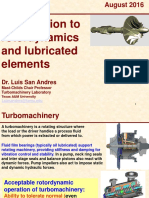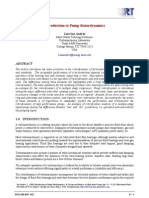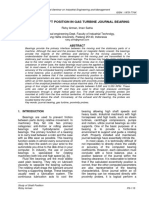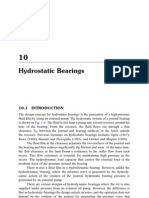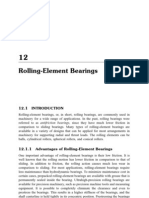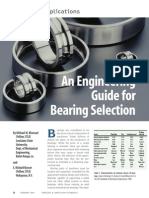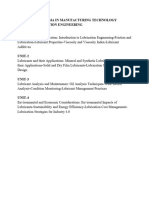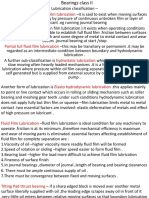Introduction To Bearing and Seals in Rotordynamics: The Most Commonly Recurring Problems in Rotordynamics Are
Introduction To Bearing and Seals in Rotordynamics: The Most Commonly Recurring Problems in Rotordynamics Are
Uploaded by
wessamalexCopyright:
Available Formats
Introduction To Bearing and Seals in Rotordynamics: The Most Commonly Recurring Problems in Rotordynamics Are
Introduction To Bearing and Seals in Rotordynamics: The Most Commonly Recurring Problems in Rotordynamics Are
Uploaded by
wessamalexOriginal Title
Copyright
Available Formats
Share this document
Did you find this document useful?
Is this content inappropriate?
Copyright:
Available Formats
Introduction To Bearing and Seals in Rotordynamics: The Most Commonly Recurring Problems in Rotordynamics Are
Introduction To Bearing and Seals in Rotordynamics: The Most Commonly Recurring Problems in Rotordynamics Are
Uploaded by
wessamalexCopyright:
Available Formats
Introduction to bearing and seals in rotordynamics
A turbomachinery is defined as a rotating structure where the load or the driver handles a
process fluid from which power is extracted or delivered to. Examples of turbomachines
include pumps and compressors, gas and steam turbines, turbo generators and turbo
expanders, turbochargers, APU (auxiliary power units), etc.
Most turbomachinery is supported on oil lubricated fluid film bearings, although modern
advances and environmental restrictions are pushing towards the implementation of
process fluid bearings and even gas bearing applications. Fluid film bearings are used due
to their adequate load support, good damping characteristics and absence of wear if
properly designed and operated.
Turbomachines also include a number of other mechanical elements which provide
stiffness and damping characteristics and affect the dynamics of the rotor-bearing system.
Impeller seals, floating ring seals, thrust collars and balance pistons are a few of these
elements.
The adequate operation of a turbomachine is defined by its ability to tolerate normal (and
even abnormal) vibrations levels without affecting significantly its overall performance
(reliability and efficiency).
The rotordynamics of turbomachinery encompasses the structural analysis of rotors
(shafts and disks) and the design of fluid film bearings and seals that determine the best
dynamic performance given the required operating conditions. This best performance is
denoted by well-characterized natural frequencies (and critical speeds) with amplitudes of
synchronous dynamic response within required standards and demonstrated absence of
subsynchronous vibration instabilities.
A rotordynamic analysis considers the interaction between the elastic and inertia
properties of the rotor and the mechanical impedances from the fluid film bearing
supports, oil seal rings, seals, etc.
The most commonly recurring problems in rotordynamics are
1. Excessive steady state synchronous vibration levels.
2. Subharmonic rotor instabilities.
Steady state vibration levels may be reduced by:
a) Improving balancing.
b) Modifying rotor-bearing systems: tune system critical speeds out of RPM operating
range.
c) Introducing damping to limit peak amplitudes at critical speeds that must be
traversed.
Subharmonic rotor instabilities may be avoided by:
a) Raising the natural frequency of rotor system as much as possible.
b) Eliminating the instability mechanism, i.e. change bearing design if oil whip is
present.
c) Introducing damping to raise onset speed above the operating speed range.
Introduction to bearings and seals. Dr. Luis San Andrés © 2000 1
Rotordynamic instabilities have become more and more common as the speed and
horsepower of turbomachinery have increased. These instabilities can sometimes be
erratic, seemingly increasing vibration amplitudes for no apparent reason. A common
denominator among many stability problems is that they tend to grow with time as the
affected component(s) begins to wear or fatigue.
For example, two typical destabilizing forces well documented in the technical literature
are due to the aerodynamic effects of labyrinth seals and the hydrodynamic effects of
cylindrical bearings and floating oil ring seals in centrifugal compressors. Load, gas
molecular weight, and oil pressure and temperature appear to be among the factors
bringing severe problems in problematic turbomachinery.
The detailed study of rotordynamics demands accurate knowledge of the specific
mechanical elements that support the rotor, i.e. fluid film bearings and seals.
Fluid film bearings
Fluid film bearings are machine elements designed to produce smooth (low friction)
motion between solid surfaces in relative motion and to generate a load support for
mechanical components. The lubricant or fluid between the surfaces may be a liquid, a
gas or even a solid.
Fluid film bearings if well designed are able to support static and dynamic loads, and
consequently, their effects on the performance of rotating machinery are of great
importance.
Our study will concentrate on the analysis of bearings with a full film separating the
mechanical surfaces. The word film implies that the fluid thickness (gap or clearance)
separating the surfaces is several orders of magnitude smaller than the other dimensions
of the bearing, i.e. width and length.
The basic operational principles of fluid film bearings are hydrodynamic, hydrostatic or
hybrid (a combination of the former two).
Hydrodynamic fluid film bearings or self-acting bearings
In these bearings there is relative motion between two mechanical surfaces with a
particular wedge shape. The fluid is dragged into the film and hydrodynamic pressures
are generated and able to support an externally applied load.
Hydrostatic fluid film bearings or externally-presurized bearings
In these bearings, an external source of pressurized fluid forces the lubricant or fluid
between the surfaces, thus providing their separation and the ability to support a load
without surface contact.
Introduction to bearings and seals. Dr. Luis San Andrés © 2000 2
Normal motions between two surfaces can also generate hydrodynamic pressures in the
thin film separating two surfaces. This mechanism, known as squeeze film action, works
effectively only for compressive loads, i.e. those forcing the approach of one surface to
the other. Squeeze film dampers are routinely implemented to reduce vibration
amplitudes and isolate structural components in gas jet engines and high performance
compressors.
Radial fluid seals (annular, labyrinth or honeycomb) separate regions of
high pressure and low pressure in rotating machinery and their function is to minimize
the leakage and improve the overall efficiency of a rotating machine extracting or
delivering power to a fluid. Typical applications include neck ring seals on impeller eyes
and interstage seals as well as balance pistons in pump and compressor applications.
Seals have larger clearances than load carrying bearings. Yet their impact on the
rotordynamics of turbomachinery is of importance since seals are located at rotor
positions where large vibrations occur.
Introduction to bearings and seals. Dr. Luis San Andrés © 2000 3
Hydrodynamic or self-acting fluid film bearings
Advantages Disadvantages
Do not require external source of pressure. Thermal effects affect performance if film
Fluid flow is dragged into the convergent thickness is too small or available flow rate
gap in the direction of the surface relative is too low.
motion.
Require of surface relative motion to
Support heavy loads. The load support is a generate load support.
function of the lubricant viscosity, surface
speed, surface area, film thickness and Induce large drag torque (power losses) and
geometry of the bearing. potential surface damage at start-up (before
Long life (infinite in theory) without wear lift-off) and touch down.
of surfaces.
Potential to induce hydrodynamic
Provide stiffness and damping coefficients instability, i.e. loss of effective damping for
of large magnitude. operation well above critical speed of rotor-
bearing system.
journal
Pressure rotation
Relative
motion
pressure
Hydrodynamic
fluid wedge
Plain journal
bearing
Slider bearing
Examples of hydrodynamic (self-acting) fluid film bearing
Introduction to bearings and seals. Dr. Luis San Andrés © 2000 4
Hydrostatic or externally pressurized fluid film bearings
Advantages Disadvantages
Support very large loads. The load support Require ancillary equipment. Larger
is a function of the pressure drop across the installation and maintenance costs.
bearing and the area of fluid pressure
action. Need of fluid filtration equipment. Loss of
performance with fluid contamination.
Load does not depend on film thickness nor
lubricant viscosity. High power consumption because of
pumping losses.
Long life (infinite in theory) without wear
of surfaces Potential to induce hydrodynamic
instability in hybrid mode operation.
Provide stiffness and damping coefficients
of very large magnitude. Excellent for Potential to show pneumatic hammer
exact positioning and control. instability for highly compressible fluids,
i.e. loss of damping at low and high
frequencies of operation due to compliance
and time lag of trapped fluid volumes.
Ps
Pressure
Pr
restrictor Fluid at Ps
recess
film
hydrostatic
journal
bearing
Examples of hydrostatic (pressurized) fluid film bearing
Introduction to bearings and seals. Dr. Luis San Andrés © 2000 5
Plain journal Partial arc Journal bearing
bearing journal bearing with axial
grooves
Elliptical Two lobe bearing Three lobe
journal bearing with offset bearing w/wo
offset
Four lobe
bearing w/wo Floating ring
offset journal bearing
Tilting pad journal
bearing
Typical configurations of cylindrical journal bearings.
Introduction to bearings and seals. Dr. Luis San Andrés © 2000 6
Dam
Top half
Bottom half
Groove
Pressure dam journal bearing
recess
hydrostatic
journal
journal
bearing
film
Supply
port
Flow of Stator
process fluid
High P Low P
Rotor
ROTATING LABYRINTH SEAL
Typical configurations of a pressure dam journal bearing,
a hydrostatic bearing and a labyrinth seal.
Introduction to bearings and seals. Dr. Luis San Andrés © 2000 7
Interstage Seal Impeller Eye Seal Balance Piston Seal
Seals in a Multistage Centrifugal Pump or Compressor
Honeycomb seal for
Compressor application
Straight-Through and Back-to-back Compressor Configurations and 1st
Mode Shapes
Introduction to bearings and seals. Dr. Luis San Andrés © 2000 8
Example of a rotordynamic analysis
The following brief description shows
the major elements of a rotordynamic
analysis performed on a seven-stage
compressor handling a light hydrocarbon
mixture.
The objectives of the rotordynamic
analysis are:
a) To model the rotor (shaft and
disks) and to determine its free-free
natural frequencies.
b) To model the fluid film bearing
and seal elements and to calculate the
mechanical impedances (stiffness,
Cut-away view of a centrifugal
compressor damping and inertia coefficients) that
connect the rotor to its casing.
c) To perform an eigenvalue analysis, i.e. to predict the natural frequencies and
damping ratios for the different modes (rigid and elastic) of vibration of the rotor
as the rotor speed increases to values well above its design operating conditions.
Positive damping ratios evidence the absence of a rotordynamic instability.
d) To perform a synchronous response analysis to calibrated imbalances in order to
predict the maximum amplitudes of vibration, the safe passage through critical
speeds and to estimate the loads transmitted through the bearing supports.
Note that the typical rotordynamic analysis is linear, i.e. it relies on the representation of
the bearings and seals as linear mechanical elements. That is, the second order
differential equations describing the motion about an equilibrium position are linear. Of
course a nonlinear analysis could also be performed but its efficiency and accuracy are
usually questionable. Furthermore, a linear analysis is mandatory to determine the
operability of the turbomachine.
It is important to stress that the tasks (objective) described above need of extensive
experimental and field support verification. Analysis without adequate measurements is
usually not very useful in rotordynamics.
The example intends to show the complexity of a typical analysis. The following figure
depicts the structural model with the rotor partitioned into 36 stations (each with inertia
and inertia properties). The circles denote added inertias such as those from the impellers
and thrust collars. The spring-like connections to ground intend to denote the bearing and
seal elements supporting the rotor.
The tables below show the physical properties of the rotor, the compressor operating
conditions (current and desired), and a brief description of the bearings and seals in place.
Introduction to bearings and seals. Dr. Luis San Andrés © 2000 9
Rotor dynamic analysis
Compressor C-2100, supported on original bearings, laby
30
seals and locked oil seals
Shaft Radius, inches
20 Bearing Floating Impeller seals Balance Floating Bearing
Ring piston ring
10
12 16 20 24 28 32 36 40 44 48 52 56
48 6063
0
Free
-10 end
-20
-30
0 20
Axial Location,
40
inches
60 80
Table 1. Geometry of rotor for compressor
Compresor C-2100 Physical units
Number of impellers 7
Shaft length 85.6 “ (2.17 m)
Rotor weight incluydes thrust collar 1,024 lb (4,550 N)
Center of mass from coupling side 43.65 “ – station 34
Mass moment of inertia (transversal0 302,815 lbm-in2
Mass moment of inertia (polar) 16,749 lbm-in2
Static load on bearing (coupling side) 469 lb (2,085 N)
Static load on bearing (free end) 554 lb (2,465 N)
Table 2. Operating conditions (actual and desired) for compresor
Hydrocarbon mixture (molecular weight 8.72)
5,700 RPM 9,850 RPM
Stage Pressure Temperature (K) Pressure Temperature (K)
(bar) (bar)
0 20.00 311.0 21.00 311
7 27.00 338.0 33.00 360
Table 3 shows the location of the mechanical impedances to ground. The rotor is
supported on two multiple lobe cylindrical bearings operating with ISO VG 32 oil.
Furthemore, pressurized floating oil seal rings isolate the process gas from the
environment. There are also seven eye impeller seals and six iinterstage seals of the
Introduction to bearings and seals. Dr. Luis San Andrés © 2000 10
labyrinth type. A long balance piston is also found at the free end of the compressor.
Appendix A provides a more detailed description of the bearings and seals, i.e.
dimensions and operating conditions.
Table 3. Bearing and seal locations on compressor
Station Mechanical element Description
8 Hydrodynamic bearing Three lobe bearing (coupling end)
56 Hydrodynamic bearing Three lobe bearing (free end)
15 Floating ring seal Pressurized, lubricant
50 Floating ring seal Pressurized, lubricant
46 Balance piston Process Gas, 27 teeth
20, 24, 28 Impulsor seals– neck ring (eye) Labyrinth type, process gas
32, 36, 40 and interstage 4 teeth
44 Eye Impulsor # 7 seal Labyrinth type, process gas
The structural analysis predicts well the free-free natural frequency of the rotor as shown
in Table 4. The free-free mode is the first elastic mode without any connection to ground,
i.e no bearings or seals. The good correlation with the field measurement is encouraging.
The field test usually consists of hanging the rotor from long cables and then raping the
shaft with a heavy objects and then recording the natural frequency (and mode shape) of
motion.
Table 4. Free-free mode natural frequency of rotor (no thrust collar)
C-2100 calculated Field measurement
Fundamental 14,431 (RPM) 14,400 (RPM)
frequency (240 Hz)
2nd frequency 27,081 ‘’ Unknown
3rd frequency 40,927 ‘’ ‘’
The rotordynamic analysis predicts the eigenvalues (damped natural frequencies) of the
rotor operating on its bearings and seals for speeds to 20,000 rpm, twice the design value.
The predictions show a lightly damped critical speed at 4,000 rpm. And most
importantly, it shows rotordynamic instability at 8,163 rpm. The field measurements
evidence of the subsynchronous vibration at a lower speed, i.e. 7.850 rpm!
Table 5. Threshold speed of instability
Threshold Whirl Whirl Mode
speed frequency ratio
predicted 8,163 rpm 4,000 rpm 0.49 Elastic
Field data 7,850 rpm 3,532 rpm 0.44 mode
Introduction to bearings and seals. Dr. Luis San Andrés © 2000 11
Rotordynamic Damped Natural Frequency Map
Rotor dynamic analysis
Compressor C2100 w ith dry-seal inertias and MODIFIED BEARINGS
20000
18000
Natural Frequency, cpm
16000
14000
12000
10000 Critical
8000
speed
6000
4000
2000
0
0. 2000. 4000. 6000. 8000. 10000. 12000. 14000. 16000. 18000. 20000.
Rotor Speed, rpm
Rotordynamic Root Locus Plot
Rotor dynamic analysis
Compressor C2100 w ith dry-seal inertias and MODIFIED BEARINGS
1.000
0.800
0.600
Damping Ratio
0.400
0.200
0.000
-0.200
0.0 2000.0 4000.0 6000.0 8000.0 10000.0 12000.0 14000.0 16000.0 18000.0 20000.0
Natural Frequency, cpm
Damped eigenvalues and damping ratios for example rotor-
bearing system.
Introduction to bearings and seals. Dr. Luis San Andrés © 2000 12
The imbalance response figures below show the amplitude of vibration versus rotor speed
and the mode of vibration at a rotor speed of 8,750 rpm. Note that the predicted results
are not valid for speeds above the threshold speed of instability since the rotor vibrates
with a subsynchronous component much larger than the one synchronous with rotor
speed.
The mode shape below shows that at the bearing locations the rotor motion is quite small
while the vibration amplitude at the seal locations (rotor midspan) is much larger. The
instability is certainly associated with a poor design and unfortunate application of the
support multiple-lobe bearings and the lockup of the oil seal rings.
Rotordynam ic Response Plot
Rotor dynamic analysis
Compressor C2100 w ith dry-seal inertias and MODIFIED BEARINGS
Sta. No. 8: drive end bearing
0.1
0.09
0.08
Response, mils p-p
0.07
Major Amp
0.06
0.05 Horz Amp
0.04 Vert Amp
0.03
0.02
0.01
0
0 2000 4000 6000 8000 10000
Rotor Speed, rpm
Damped Eigenvalue Mode Shape Plot
Rotor dynamic analysis
Compressor C2100 w ith dry-seal inertias and MODIFIED BEARINGS
forward
backward
f=4041. cpm
d=-.0007 zeta
N=8750 rpm
Synchronous imbalance response and first elastic damped mode
shape for compressor example.
Introduction to bearings and seals. Dr. Luis San Andrés © 2000 13
The last figure below shows the field recorded vibration spectra. The rotor speed is 7,860
rpm and the dangerously high amplitude subsynchronous vibration develops at 3,532
rpm. The rotordynamic predictions are overly conservative!
B - C-103 FCC GAS COMP
C-103 -8V COMP OUTBOARD BRG - VERT
*
4.5
Route Spectrum
4.0 01-DEC-97 15:40
3.5 OVRALL= 3.69 D-DG
P-P Displacement in Mils
P-P = 3.67
3.0
LOAD = 100.0
RPM = 7850.
2.5
RPS = 130.83
2.0
1.5
1.0
0.5
0
Freq: 3496.9
0 6000 12000 18000 24000 30000
Ordr: .445
Frequency in CPM Spec: 3.159
Field vibration spectrum showing rotordynamic instability for
compressor example.
The example evidences the importance of fluid film bearings and seals on the dynamics
of rotating machinery. Note that the example referred brought an unexpected stop in the
operation of the unit with an enormous cost to the owner, several hundred thousand of
dollars per day over an undisclosed amount of time. Fortunately, current monitoring
techniques enabled the engineers to prevent a catastrophic failure with a larger financial
and human cost.
Closure
The following lectures (and notes) provide the fundamentals of fluid film lubrication and
rotordynamics that will enable the reader to analyze fluid film bearings and seals for
applications in turbomachinery. The study initiates with a detailed analysis of the
fundamentals of lubrication theory and its applications to oil-lubricated bearings and ring
seals. Next, seals and squeeze film dampers are thoroughly covered. The importance of
fluid inertia and flow turbulence on modern and envisioned bearing and seal applications
is also studied.
Introduction to bearings and seals. Dr. Luis San Andrés © 2000 14
Performance Objectives for Lubrication Class
1. To learn about the physical concepts and mathematical models for the analysis
and design of fluid film bearings and seals.
2. To acquire knowledge based on the detailed review of the literature on fluid film
lubrication and rotordynamics.
3. To identify the mechanical effects of importance on the static and dynamic forced
performance of fluid film bearings.
4. To learn about the effects of fluid film bearings on the rotordynamics of
turbomachinery.
5. To identify the future trends in applications of bearing and seal technologies and
the needs for further research.
6. To provide the basics of efficient computational skills for the prediction of the
static and dynamic forced performance of fluid film bearings.
Introduction to bearings and seals. Dr. Luis San Andrés © 2000 15
You might also like
- WILFLEX® EPIC MIXING SYSTEM Formulation Guide - PolyOneDocument98 pagesWILFLEX® EPIC MIXING SYSTEM Formulation Guide - PolyOneJulian Medina OspinaNo ratings yet
- Bearing DesignDocument58 pagesBearing DesignCaryann Gumban100% (1)
- Asset Inspection Procedures PDFDocument100 pagesAsset Inspection Procedures PDFwessamalexNo ratings yet
- Rotor DynamicsDocument43 pagesRotor Dynamicslopes_anderson5078No ratings yet
- Pump RotordynamicsDocument26 pagesPump RotordynamicsHalil İbrahim Küplü100% (1)
- Introduction of Hydrostatic Bearing: by Shashi Bhushan Guided By: Prof. Mr. S.A.UthaleDocument12 pagesIntroduction of Hydrostatic Bearing: by Shashi Bhushan Guided By: Prof. Mr. S.A.UthalesankhyansbNo ratings yet
- Hydrostatic Bearing: Advantages DisadvantagesDocument1 pageHydrostatic Bearing: Advantages DisadvantagesSandesh ThapaNo ratings yet
- Hydrostatic & Hydrodynamic Bearing: Name:Kalani Mitesh H. Machine Tool EnggDocument12 pagesHydrostatic & Hydrodynamic Bearing: Name:Kalani Mitesh H. Machine Tool EnggMitesh KalaniNo ratings yet
- Hydrostatic LubricationDocument24 pagesHydrostatic LubricationSharat ChandraNo ratings yet
- Fluid Bearing - WikipediaDocument8 pagesFluid Bearing - Wikipediaslam12125No ratings yet
- Term Paper On Elastohydrodynamic LubricationDocument10 pagesTerm Paper On Elastohydrodynamic Lubricationwilliam ubongNo ratings yet
- Study of Shaft Position in Gas Turbine Journal BearingDocument7 pagesStudy of Shaft Position in Gas Turbine Journal Bearingarindam misraNo ratings yet
- Hydrostatic Bearings For Cryogenic ApplicationsDocument4 pagesHydrostatic Bearings For Cryogenic ApplicationsAlbertoNo ratings yet
- Tribology International: J. Bouyer, M. Wodtke, M. FillonDocument12 pagesTribology International: J. Bouyer, M. Wodtke, M. FillonAhmad Murtadlo ZakaNo ratings yet
- Tribology International: D.J. Ramos, G.B. DanielDocument11 pagesTribology International: D.J. Ramos, G.B. DanielgbregionNo ratings yet
- "Starved Lubrication in Ehd Contacts": Mr. Sachin A. MoreDocument7 pages"Starved Lubrication in Ehd Contacts": Mr. Sachin A. MoreSACHIN A. MORENo ratings yet
- Aade 11 Ntce 75 PDFDocument8 pagesAade 11 Ntce 75 PDFrinshonsanNo ratings yet
- Elemen Mesin II - 3c_lubricantsDocument28 pagesElemen Mesin II - 3c_lubricantsJuniar HepyNo ratings yet
- DK1915 CH10Document55 pagesDK1915 CH10gao379No ratings yet
- LOAD INFLUENCE ON HYDROSTATIC OIL FILM JOURNAL BEARING STIFFNESS (PT Film-Rig)Document10 pagesLOAD INFLUENCE ON HYDROSTATIC OIL FILM JOURNAL BEARING STIFFNESS (PT Film-Rig)Alice MarinescuNo ratings yet
- Hydrostatic Journal BearingDocument14 pagesHydrostatic Journal Bearingapi-19775783100% (4)
- Lubricants 12 00346 With CoverDocument12 pagesLubricants 12 00346 With Coverjacky hanNo ratings yet
- Squeeze Film BearingDocument6 pagesSqueeze Film Bearingsuresh krishnaNo ratings yet
- Fluid BearingDocument3 pagesFluid Bearingyousafsappal795No ratings yet
- DK1915 CH12Document70 pagesDK1915 CH12gao379100% (1)
- Numerical Modelling of Hydrostatic Lift Pockets inDocument9 pagesNumerical Modelling of Hydrostatic Lift Pockets inAli HegaigNo ratings yet
- Friction and Lubrication of Large Tilting Pad Thrust BearingsDocument17 pagesFriction and Lubrication of Large Tilting Pad Thrust BearingsmispalabrasdesordenadasNo ratings yet
- A Review of Tilting Pad Bearing TheoryDocument31 pagesA Review of Tilting Pad Bearing TheoryJose Luis RattiaNo ratings yet
- Vacuum SystemsDocument1 pageVacuum SystemsEsteban Calderón NavarroNo ratings yet
- Class20 Lubrication 2012 1Document10 pagesClass20 Lubrication 2012 1anhntran4850No ratings yet
- 978-1-4612-2364-1 - 8 LubricationsDocument2 pages978-1-4612-2364-1 - 8 LubricationsApeksha SinghNo ratings yet
- Simrit 03 - Hydraulics (Technical Manual 2007)Document312 pagesSimrit 03 - Hydraulics (Technical Manual 2007)jo_rz_57100% (1)
- Annular Pressure Seals and Hydrostatic Bearings: Luis San AndrésDocument36 pagesAnnular Pressure Seals and Hydrostatic Bearings: Luis San AndrésisidropeNo ratings yet
- Review of Tilting Pad Lubrication TheoryDocument24 pagesReview of Tilting Pad Lubrication Theoryhimadri.banerji60No ratings yet
- CFD Analysis On Hydrodynamic Plain Journal Bearing Using Fluid Structure Interaction TechniqueDocument7 pagesCFD Analysis On Hydrodynamic Plain Journal Bearing Using Fluid Structure Interaction TechniquezzzNo ratings yet
- #Tribology Module 56Document159 pages#Tribology Module 56A BNo ratings yet
- A Review of Tilting Pad Bearing Theory PDFDocument24 pagesA Review of Tilting Pad Bearing Theory PDFJohn KokarakisNo ratings yet
- Development of A Low-Friction Radial Shaft Seal UsDocument15 pagesDevelopment of A Low-Friction Radial Shaft Seal UsAnissa LamraniNo ratings yet
- BearingDocument23 pagesBearingAhmed Gad100% (1)
- In Pursuit of Better Bearings - . .: Inadequate Pressurization Can Exacerbate Fluid InstabilityDocument10 pagesIn Pursuit of Better Bearings - . .: Inadequate Pressurization Can Exacerbate Fluid InstabilityHatem AbdelrahmanNo ratings yet
- Hydrostatic PM Controller Contributes To Accuracy of Machining Operations and Machine Service LifeDocument5 pagesHydrostatic PM Controller Contributes To Accuracy of Machining Operations and Machine Service LifeRadhakrishnan ChinnavadanNo ratings yet
- Hydrodynamic Lubrication AssignmentDocument7 pagesHydrodynamic Lubrication AssignmentHARISH JANGRANo ratings yet
- LH Max Expandable Liner Hanger System PsDocument2 pagesLH Max Expandable Liner Hanger System Psharshpatel18No ratings yet
- Generator Performance Plus PDFDocument4 pagesGenerator Performance Plus PDFkamal arab100% (1)
- Principles of Hydrodynamic Lubrication: Fig. 1-2 Fig. 1-3Document27 pagesPrinciples of Hydrodynamic Lubrication: Fig. 1-2 Fig. 1-3gao379No ratings yet
- ERIKS Merkel Technical ManualDocument106 pagesERIKS Merkel Technical ManualRaasik Jain100% (2)
- Engineering Guide For Bearing SelectionDocument7 pagesEngineering Guide For Bearing SelectionbmspragueNo ratings yet
- Hydrodynamic Bearing PDFDocument4 pagesHydrodynamic Bearing PDFAndrey ZagorulkoNo ratings yet
- CJBrochureDocument16 pagesCJBrochurejcvf1No ratings yet
- SealsDocument118 pagesSealsBalachandar Sathananthan50% (2)
- Bearings and Their ApplicationDocument4 pagesBearings and Their ApplicationAkarsh AdiNo ratings yet
- Bearing Types and SelectionDocument22 pagesBearing Types and Selectionsivajirao70No ratings yet
- Mechanical Systems and Signal Processing: Christopher DellacorteDocument10 pagesMechanical Systems and Signal Processing: Christopher DellacortepooyakhpNo ratings yet
- Paper-1 Lubrication EngineeringDocument98 pagesPaper-1 Lubrication EngineeringjoelprithivNo ratings yet
- Hydrodynamic or Full Fluid Film LubricationDocument59 pagesHydrodynamic or Full Fluid Film LubricationAbhishek Singh ChauhanNo ratings yet
- Experimental Investigation of Oil Film Thickness For Hydrodynamic Journal BearingsDocument7 pagesExperimental Investigation of Oil Film Thickness For Hydrodynamic Journal Bearingskishorghatage89No ratings yet
- Hydrodynamic LubricationDocument3 pagesHydrodynamic LubricationYoga YogaswaraNo ratings yet
- Bearings And Bearing Metals: A Treatise Dealing with Various Types of Plain Bearings, the Compositions and Properties of Bearing Metals, Methods of Insuring Proper Lubrication, and Important Factors Governing the Design of Plain BearingsFrom EverandBearings And Bearing Metals: A Treatise Dealing with Various Types of Plain Bearings, the Compositions and Properties of Bearing Metals, Methods of Insuring Proper Lubrication, and Important Factors Governing the Design of Plain BearingsRating: 4 out of 5 stars4/5 (1)
- Part 2 Instrumentation and Control Dr. Ahmed Kamel 505Document23 pagesPart 2 Instrumentation and Control Dr. Ahmed Kamel 505wessamalex100% (5)
- 8-Pumps General ClasificationDocument62 pages8-Pumps General Clasificationwessamalex100% (1)
- 2-General Intro. of PumpDocument45 pages2-General Intro. of Pumpwessamalex100% (1)
- Part 1 Dr. Ahmed Kamel 505Document36 pagesPart 1 Dr. Ahmed Kamel 505wessamalex100% (1)
- ASME Brochure - Sept 2014 - June 2015Document4 pagesASME Brochure - Sept 2014 - June 2015wessamalexNo ratings yet
- 6th Central Pay Commission Salary CalculatorDocument15 pages6th Central Pay Commission Salary Calculatorrakhonde100% (436)
- Broch 2196Document3 pagesBroch 2196wessamalexNo ratings yet
- High Speed and Long Life Double-Row Cylindrical Roller BearingsDocument4 pagesHigh Speed and Long Life Double-Row Cylindrical Roller Bearingswessamalex100% (1)
- T2157 64Document8 pagesT2157 64wessamalexNo ratings yet
- Suez Oil Company: Zeit Bay Field OriginatorDocument1 pageSuez Oil Company: Zeit Bay Field OriginatorwessamalexNo ratings yet
- Suez Oil Company: B-2501A/C B-2501B/DDocument1 pageSuez Oil Company: B-2501A/C B-2501B/DwessamalexNo ratings yet
- Proc 0603E001Document1 pageProc 0603E001wessamalexNo ratings yet
- Suez Oil Company: B-2501A/C LP Compression Train B-2501B/D HP Compression TrainDocument1 pageSuez Oil Company: B-2501A/C LP Compression Train B-2501B/D HP Compression TrainwessamalexNo ratings yet
- 4.1characteristics & Quality Attributes of Embedded Systems: ST NDDocument24 pages4.1characteristics & Quality Attributes of Embedded Systems: ST NDSudarshanaNo ratings yet
- Computer Organisation Worksheet 2A AnswersDocument2 pagesComputer Organisation Worksheet 2A Answerskhangdt.stNo ratings yet
- Surge Arrester Monitor: Transinor AsDocument8 pagesSurge Arrester Monitor: Transinor AsVictor RochaNo ratings yet
- First Orientation For International Students: @tuhhDocument21 pagesFirst Orientation For International Students: @tuhhbitawoj789No ratings yet
- Iso 13938 2 2019Document9 pagesIso 13938 2 2019Wafa BEN AHMEDNo ratings yet
- Manómetro 118ADocument4 pagesManómetro 118AmetrologiatramitesNo ratings yet
- Chapter 9 Resource ManagementDocument6 pagesChapter 9 Resource ManagementAmmar YasirNo ratings yet
- Practical Slips SolutionDocument30 pagesPractical Slips Solutiononkarrahane7No ratings yet
- Well ViewDocument1 pageWell Viewoa3740523No ratings yet
- ADMS3510 F21 Final Exam Question 1 - Student TemplateDocument32 pagesADMS3510 F21 Final Exam Question 1 - Student TemplateChirag KundaliaNo ratings yet
- Man 1147Document20 pagesMan 1147youcef mokraneNo ratings yet
- Kar Design 2506Document72 pagesKar Design 2506Shashank BahiratNo ratings yet
- Project ProposalDocument7 pagesProject ProposalClarisse100% (3)
- Asrat Simru AppDocument36 pagesAsrat Simru Apptadiso birkuNo ratings yet
- Chanel Social Media StrategiesDocument5 pagesChanel Social Media StrategiesAaditi guptaNo ratings yet
- Hotel Management Term PaperDocument6 pagesHotel Management Term Paperea6xrjc4100% (1)
- HRM AssignmentDocument5 pagesHRM AssignmentApurv KothariNo ratings yet
- Adaptive Second-Order Active-Flux Observer For Sensorless Control of PMSMs With MRAS-Based VSI Nonlinearity Compensation (2023)Document11 pagesAdaptive Second-Order Active-Flux Observer For Sensorless Control of PMSMs With MRAS-Based VSI Nonlinearity Compensation (2023)Armin ShabaniNo ratings yet
- Database TutorialDocument9 pagesDatabase Tutorialnkafor7No ratings yet
- UD35434B Digital-Video-Recorder User-Manual V4.51.100 20231109Document188 pagesUD35434B Digital-Video-Recorder User-Manual V4.51.100 20231109tidowod192No ratings yet
- Manual For Goaml Web 1Document30 pagesManual For Goaml Web 1MashudNo ratings yet
- Thermodynamics: Name: ScoreDocument5 pagesThermodynamics: Name: ScoreROBERT ABRILNo ratings yet
- Alonzo Bsce-2d Assignment 10Document8 pagesAlonzo Bsce-2d Assignment 10Abraham Paul AlonzoNo ratings yet
- Human Resource Strategy FinalDocument18 pagesHuman Resource Strategy Finalstephen changayaNo ratings yet
- Management Systems: ... Save Money With Improved Fleet PerformanceDocument16 pagesManagement Systems: ... Save Money With Improved Fleet PerformanceMartino Ojwok AjangnayNo ratings yet
- Mojotone PAF Humbucker Kit Instructions: Before You Get Started ConsiderDocument12 pagesMojotone PAF Humbucker Kit Instructions: Before You Get Started ConsiderlorenzoNo ratings yet
- BMR-PIP-DTS-ST-0001 DATA SHEET FOR VALVE Rev. ADocument19 pagesBMR-PIP-DTS-ST-0001 DATA SHEET FOR VALVE Rev. AAgus SupriadiNo ratings yet
- RDA1846 Programming ManualDocument27 pagesRDA1846 Programming Manualserga333No ratings yet
- KhjjytrrDocument1 pageKhjjytrrncirNo ratings yet



